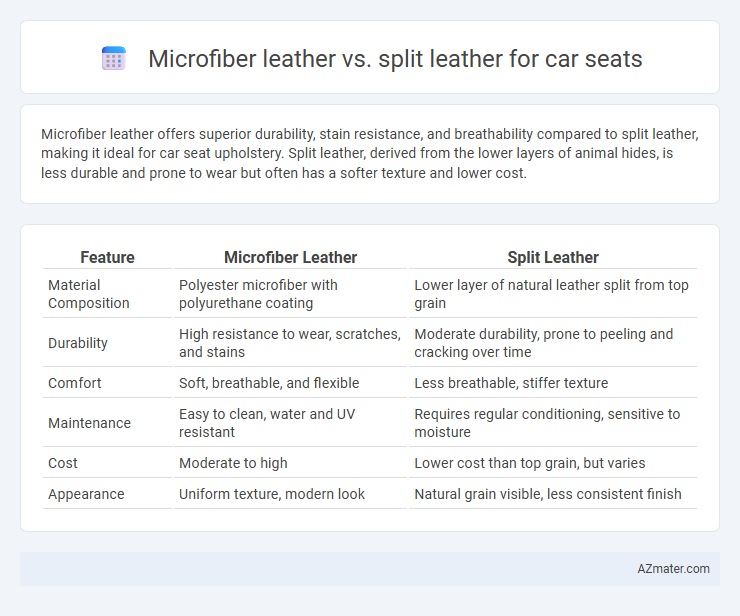Microfiber leather offers superior durability, stain resistance, and breathability compared to split leather, making it ideal for car seat upholstery. Split leather, derived from the lower layers of animal hides, is less durable and prone to wear but often has a softer texture and lower cost.
Table of Comparison
| Feature | Microfiber Leather | Split Leather |
|---|---|---|
| Material Composition | Polyester microfiber with polyurethane coating | Lower layer of natural leather split from top grain |
| Durability | High resistance to wear, scratches, and stains | Moderate durability, prone to peeling and cracking over time |
| Comfort | Soft, breathable, and flexible | Less breathable, stiffer texture |
| Maintenance | Easy to clean, water and UV resistant | Requires regular conditioning, sensitive to moisture |
| Cost | Moderate to high | Lower cost than top grain, but varies |
| Appearance | Uniform texture, modern look | Natural grain visible, less consistent finish |
Overview: Microfiber Leather vs Split Leather for Car Seats
Microfiber leather offers superior durability, water resistance, and a softer texture compared to split leather, making it an ideal choice for high-use car seats. Split leather, derived from the fibrous part of the hide, tends to be less resilient and prone to wear and tear, but it is more affordable. Both materials provide aesthetic appeal, yet microfiber leather combines practicality with longevity, enhancing the overall comfort and maintenance of car interiors.
Material Composition: What Are Microfiber Leather and Split Leather?
Microfiber leather consists of a base fabric made from ultra-fine synthetic fibers combined with a polyurethane coating, offering high durability, breathability, and water resistance ideal for car seats. Split leather is derived from the lower layers of cowhide, where the top grain is removed, resulting in a more porous material that requires additional surface treatments to enhance softness and durability. Microfiber leather's synthetic composition provides consistent texture and color, while split leather's natural origin offers a softer feel but potentially less uniformity and higher maintenance.
Durability and Longevity Comparison
Microfiber leather offers superior durability and resistance to wear compared to split leather, making it ideal for high-traffic car seat use. Split leather tends to be less durable due to its fibrous nature, which can lead to quicker deterioration and wear over time. Microfiber's synthetic composition enhances longevity by resisting stains, scratches, and fading, outperforming split leather in maintaining a fresh, new appearance.
Comfort and Feel: User Experience
Microfiber leather offers a smoother, softer texture compared to split leather, providing enhanced comfort during long drives. Split leather, derived from the lower layer of cowhide, tends to be rougher and less breathable, which can lead to discomfort in extreme temperatures. Users often prefer microfiber leather for its consistent feel and durability, contributing to a more luxurious and pleasant seating experience in vehicles.
Aesthetic Appeal and Customization Options
Microfiber leather offers a sleek, uniform appearance with a smooth texture that enhances the interior's modern aesthetic, while split leather presents natural grain patterns and slight imperfections for a more classic and authentic look. Customization options with microfiber leather include a wider range of colors and finishes due to its synthetic composition, enabling precise design choices tailored to car interiors. Split leather, derived from genuine hides, allows for traditional embossing and patina development, providing a unique and evolving aesthetic over time, but with fewer color variations than microfiber alternatives.
Maintenance and Cleaning Requirements
Microfiber leather offers superior resistance to stains and water, making maintenance and cleaning more straightforward with just a mild soap solution and a soft cloth, ideal for car seats exposed to frequent spills. Split leather, being more porous, demands specialized leather cleaners and conditioners to prevent drying and cracking, requiring more frequent and careful upkeep. The durability of microfiber leather ensures longer-lasting appearance with minimal effort compared to split leather, which needs regular attention to maintain its texture and prevent deterioration.
Cost Comparison: Which Is More Affordable?
Microfiber leather typically costs less than split leather due to lower production expenses and synthetic material sourcing. Split leather involves more complex processing from genuine cowhide, resulting in higher prices for car seat upholstery. Choosing microfiber leather offers a budget-friendly option without compromising durability and aesthetic appeal in vehicle interiors.
Environmental Impact and Sustainability
Microfiber leather offers a more sustainable alternative to split leather by utilizing synthetic fibers derived from recycled materials, reducing reliance on animal hides and minimizing landfill waste. Split leather production involves extensive chemical treatments and water consumption, leading to higher environmental pollution compared to the less resource-intensive manufacturing process of microfiber leather. Choosing microfiber leather for car seats supports lower carbon emissions and promotes eco-friendly automotive interiors, aligning with green sustainability goals.
Resistance to Wear, Tear, and Fading
Microfiber leather exhibits superior resistance to wear, tear, and fading compared to split leather, thanks to its dense synthetic fibers and advanced coating technology. Split leather, derived from the fibrous layer beneath the hide's surface, tends to be less durable and more prone to scratches and color degradation over time. For car seats, microfiber leather provides enhanced longevity and maintains its appearance under frequent use and exposure to sunlight.
Best Choice for Car Seats: Microfiber Leather or Split Leather?
Microfiber leather offers superior durability, breathability, and resistance to stains compared to split leather, making it a practical choice for car seats subject to daily wear and tear. Split leather, derived from the lower layers of animal hide, tends to be less durable and more prone to cracking and fading over time, reducing its longevity in automotive interiors. For optimal comfort, maintenance, and long-term value, microfiber leather stands out as the best material choice for car seat upholstery.

Infographic: Microfiber leather vs Split leather for Car seat
 azmater.com
azmater.com